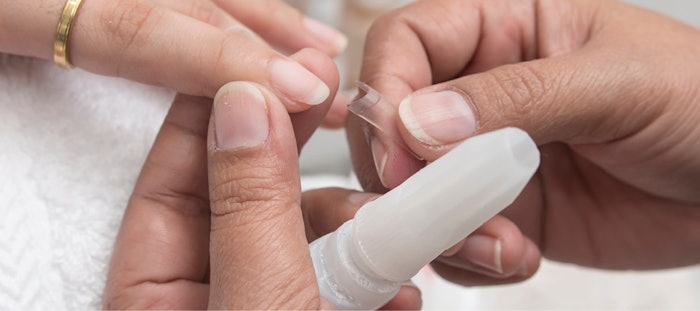
In the world of beauty and fashion, nails have become a canvas for self-expression, allowing individuals to showcase their personal style and creativity.
However, with the fast pace that we all keep, consumers want everything to be instantaneous, even creativity! Very often, nail glues play a big role in enabling this for nail professionals and consumers. From adhering tips to elongate natural nail in salons to using press-ons for a quick fix for that big night, nail glues have found wide variety of applications in this industry.
Today, nail glues are commonly used to adhere nail tips, nail embellishments, press-on nails and even for dip powders. The complete dip powder category is based on nail glue technology to enable beautiful, strong and long-lasting nail service for consumers. So, what is nail glue? How does it enable such quick and easy fix for all of us?
What Are Nail Glues?
Nail glues are based on a category of materials called “cyanoacrylates.” The adhesive properties of cyanoacrylates were first discovered by accident in 1951 when Eastman Kodak Company scientists found that their testing equipment had been glued together. Not for the first time, a lab accident led to product development, and Eastman launched the first commercial cyanoacrylate glue in 1958. The versatility of this adhesive chemistry to join a variety of substrates, with fast bonding and high bond strength, and the simplicity in application quickly made cyanoacrylate adhesives one of most popular adhesives used around the world.
They are not only used in industrial and consumer applications, but also have been a prime candidate for medical applications including dentistry and emergency wound closure, especially as tissue adhesives and sealing materials, due to their fast-setting characteristics in wet environment to form strong flexible bonds.
The most common cyanoacrylate in our industry is ethyl 2-cyanoacrylate, which is called simply “ethyl cyanoacrylate” by international cosmetic labeling conventions. Other ingredients in nail glue may include very small levels of antioxidant stabilizers to improve the product’s shelf life, and, in some cases, a thickening agent (usually a methacrylate polymer) if a slower flow is desired.
Science of Glue
Cyanoacrylate glue belongs to a family of fast-acting, one-part adhesives known as acrylic resins. The main component of these glues is an acrylic monomer called cyanoacrylate. The monomer exists in a liquid form, allowing it to flow and penetrate into small gaps or pores.
The key scientific process that occurs when cyanoacrylate glue is applied is polymerization. Polymerization is a chemical reaction in which small molecules, called monomers, join together to form a large, interconnected network called a polymer. In the case of cyanoacrylate glue, the reaction is initiated by the presence of moisture, specifically the hydroxyl ions (OH-) found in water or humidity.
When cyanoacrylate glue comes into contact with moisture, the hydroxyl ions trigger a rapid polymerization reaction. This reaction results in the formation of strong, interconnected polymer chains, which solidify and harden the glue. The resulting polymer formed by the polymerization reaction exhibits excellent bonding properties. The bonds formed are characterized by high tensile strength and shear resistance, making cyanoacrylate glue suitable for a variety of applications, from household repairs, industrial manufacturing and attaching press on nails!
Next time you reach for a tube of cyanoacrylate glue, take a moment to appreciate the scientific principles at work, enabling you to create strong and durable bonds in an instant.
Why Do We Use Cyanoacrylates as Nail Glue?
Cyanoacrylates have several advantages over contemporary counterparts, such as fast, tack-free cure, good bonding strength and dual cure modes. Cyanoacrylates cure instantly, on contact with small amount of moisture in air or on typical nail surfaces, making them ideal for adhering tips or press-ons with the application of little pressure. The polymer forms within a matter of minutes, creating a strong bond. With recent advances in glue technology, press-ons can last for days, even weeks at a time. As cyanoacrylates have different curing mechanism compared to gels, there is no tacky layer on the surface post cure. Thus, we do not need to wipe the surface after service. Despite the bond strength, the polymer can be easily removed by soaking it in acetone.
Nail glues, in combination with activator, are used in dip powder nail systems to bond and fuse the powder together on the nail bed. The activator contains a substance similar to curing agent in acrylic liquid monomers. Once activated, the cyanoacrylate forms polymeric chains around the powder and adheres it to the nail bed, holding the entire system together. Such a tight bond between powder and resin makes the dip system extraordinarily strong and the service long-lasting. This technology makes it possible to have great nails without using UV lamps.
Safe Application of Cyanoacrylates
As with all products, safety should be practiced with cyanoacrylate. Always be careful and follow normal salon precautions. Particularly, avoid skin and eye contact since cyanoacrylates can glue them instantly. Also, avoid contact with clothes, towels and other fabric. Finally, store cyanoacrylates in a cool, dark place for maximum shelf life.
Cyanoacrylate-based nail glues have been making the lives of nail professionals and consumers easy for quite some time now. When used according to manufacturer’s directions, they are safe, fast, easy to apply and remove and deliver optimal performance and a hassle-free experience.
Reference:
- P. Rajesh Raja, Cyanoacrylate Adhesives: A Critical Review, Rev. Adhesion Adhesives, Vol. 4, No. 4, December 2016
About the Author:
Chaitrali Gothe is the princpal scientist with OPI.












